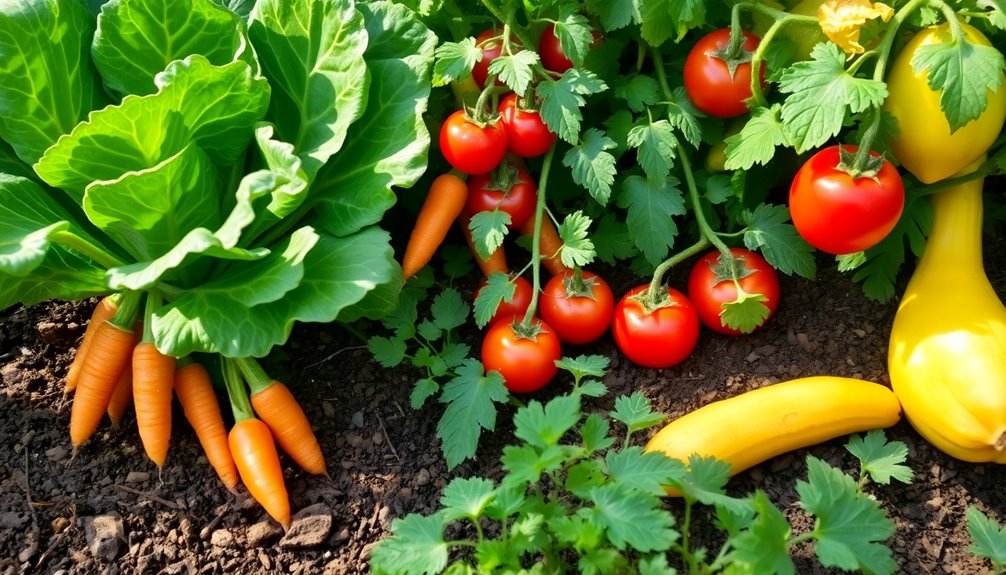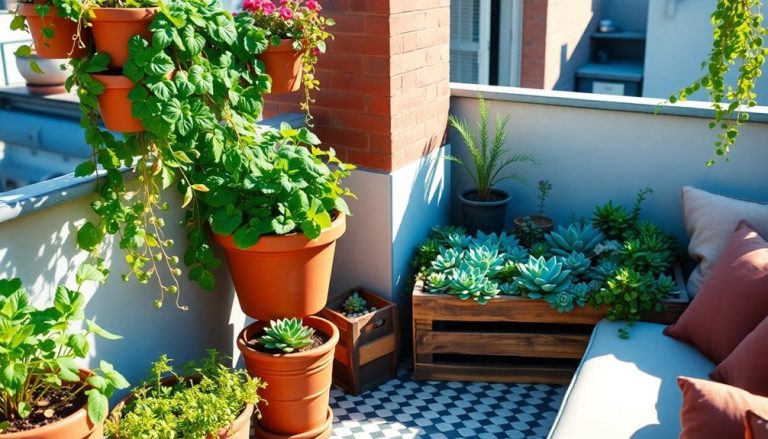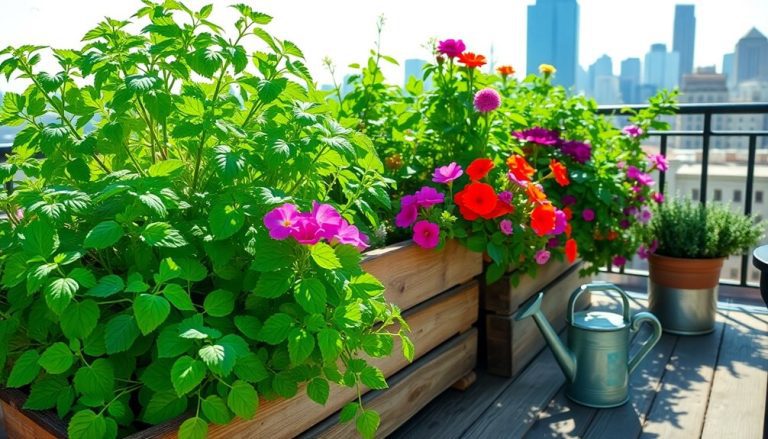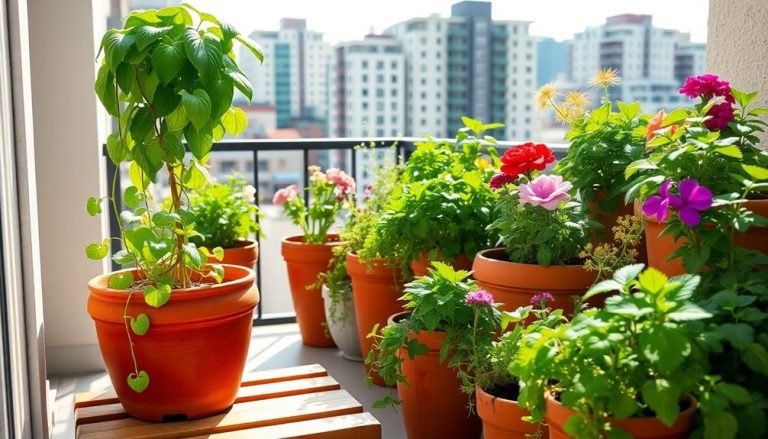To achieve success in your small garden, focus on compact, easy-to-grow vegetables. Leafy greens like spinach and lettuce thrive without deep soil, making them perfect for limited spaces. Radishes and carrots offer fast harvests and require minimal care. Don't forget cherry tomatoes and peppers—they love the sun and yield tasty fruits. Cucumbers can climb on trellises, maximizing your area efficiently. Toss in some herbs for added flavor and variety. These choices will keep your garden lush and productive. Stay tuned for more tips to help your small garden flourish!
Key Takeaways
- Leafy greens like lettuce and spinach are quick to grow and thrive in small spaces, providing a steady supply of fresh greens.
- Root vegetables such as radishes and carrots are easy to cultivate and offer high nutrient value; they grow well in loose, well-drained soil.
- Fruiting vegetables like cherry tomatoes and peppers are compact, flavorful options that flourish in containers with adequate sunlight and support.
- Cucumbers can be grown vertically using trellises, maximizing space while ensuring good air circulation and easy harvesting.
- Growing herbs in containers adds fresh flavors to dishes and requires minimal space, enhancing your garden's productivity and culinary potential.
Leafy Greens
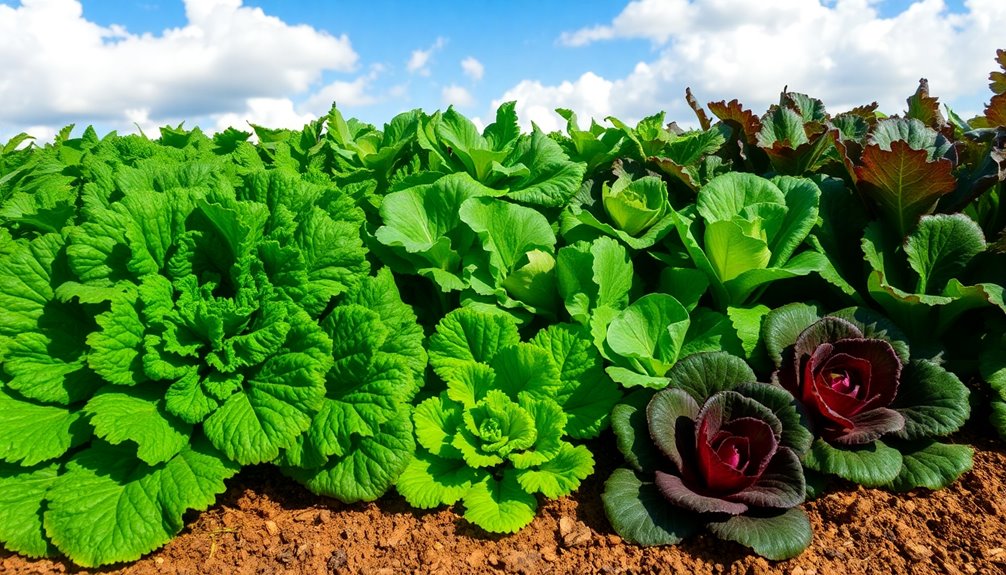
Leafy greens are some of the easiest and most rewarding vegetables to grow in small gardens. Whether you're a novice or an experienced gardener, they thrive in limited spaces and offer quick harvests.
To start, choose varieties like lettuce, spinach, or kale, which don't require deep soil and can flourish in shallow containers.
Plant your seeds directly in the soil or in seed trays, and make sure to keep them consistently moist. With a little sunlight and regular watering, you'll see them sprout within days. You can harvest your greens at any stage, allowing you to enjoy fresh salads and smoothies throughout the season.
Don't forget to practice succession planting. By sowing new seeds every couple of weeks, you'll ensure a steady supply of greens. Also, consider interplanting with herbs or radishes; this maximizes your space and can deter pests.
Leafy greens are generally low-maintenance and can withstand varying temperatures, making them perfect for beginner gardeners.
Radishes
Radishes are another fantastic choice for small gardens, complementing your leafy greens perfectly. These vibrant root vegetables grow quickly, usually maturing in just three to four weeks, making them an ideal option for your limited space. You can plant them in early spring or late summer, allowing for multiple harvests throughout the growing season.
When you choose to grow radishes, opt for a sunny spot with well-drained soil. They thrive best in loose, fertile dirt, so consider amending your soil with compost to enhance growth. You can plant radish seeds directly in the ground, spacing them about an inch apart. As they grow, thin out the seedlings to give the remaining plants room to expand.
Radishes are versatile, too. You can enjoy them raw in salads, pickled, or cooked in various dishes. Plus, they're packed with nutrients like vitamin C and fiber, making them a healthy addition to your meals.
With minimal maintenance and a quick turnaround, radishes can be a rewarding crop for your small garden, providing a burst of color and flavor that complements your leafy greens beautifully.
Cherry Tomatoes

Cherry tomatoes are a delightful addition to small gardens, offering bursts of sweetness that can elevate any dish. They're not only tasty but also easy to grow, making them perfect for gardeners of all experience levels.
Choose a sunny spot in your garden, as cherry tomatoes thrive in full sunlight.
When planting, opt for compact varieties like 'Tiny Tim' or 'Tumbling Tom' if space is tight. These varieties grow well in containers or hanging baskets, allowing you to maximize your garden space.
Make sure to use quality potting soil for container gardening and provide support like stakes or cages as your plants grow.
Water your cherry tomatoes consistently, keeping the soil moist but not soggy. Fertilizing every few weeks with a balanced fertilizer will also encourage healthy growth and abundant fruit.
Keep an eye out for pests, and don't hesitate to use organic methods to control them if needed.
Harvest your cherry tomatoes when they're fully colored and slightly firm. Enjoy them fresh, toss them in salads, or roast them for a delicious treat.
With just a little attention, you'll be rewarded with a bountiful harvest of these sweet gems!
Peppers
When it comes to maximizing your small garden, peppers are a vibrant and versatile choice. They come in various shapes, sizes, and colors, making them not only delicious but also visually appealing. Whether you prefer sweet bell peppers or fiery hot varieties, there's a pepper to suit your taste and gardening style.
Peppers thrive in warm weather, so plant them after the last frost. Choose a sunny spot in your garden, as they need at least six hours of sunlight each day. If space is tight, consider using containers or vertical gardening techniques. This way, you can have a colorful pepper display without taking up too much ground.
Water your peppers consistently, but be careful not to overwater. Well-draining soil is crucial for healthy plants. You can also boost their growth with organic fertilizers.
As the peppers develop, you'll enjoy watching them change colors, adding excitement to your garden. Harvest your peppers when they're firm and glossy. Picking them regularly encourages more fruit production.
With a little attention and care, growing peppers in your small garden can lead to a bountiful and flavorful harvest!
Carrots
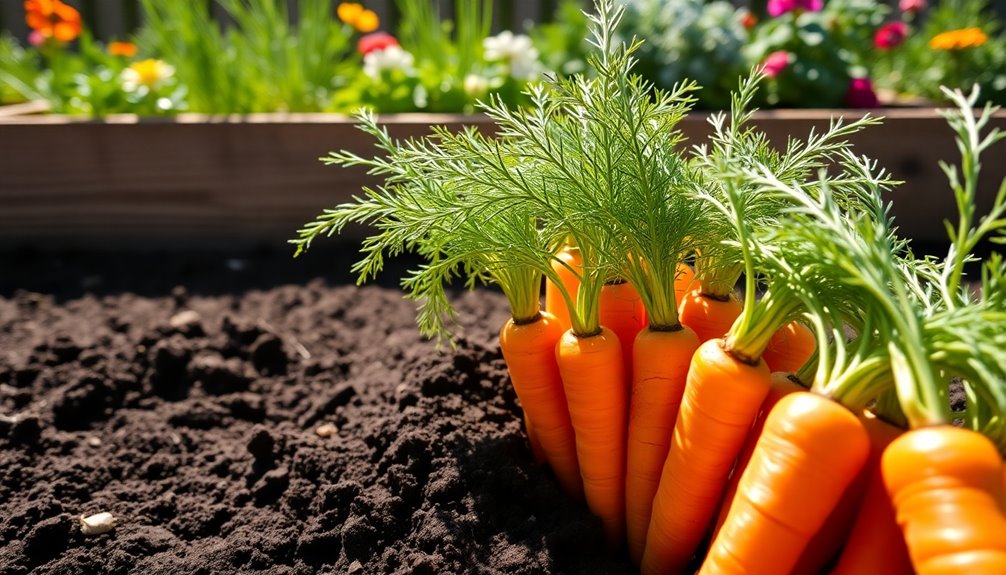
Carrots are often a favorite among small garden enthusiasts due to their easy growth and rewarding harvest. They thrive in well-drained, loose soil, making them perfect for containers or raised beds.
To start, choose a sunny spot in your garden and prepare the soil by removing rocks and debris. You can sow seeds directly into the ground, spacing them about 2-4 inches apart.
Water the seeds lightly but consistently, as carrots prefer moist soil, especially during germination. In about 2-3 weeks, you'll see those tiny green tops sprouting. Thin the seedlings to ensure they've enough room to grow, ideally leaving 3-4 inches between each plant.
Carrots come in various colors and sizes, so feel free to experiment with different varieties. Keep an eye out for pests like carrot flies, and consider using row covers for protection.
Harvest your carrots when they reach a good size, usually around 2-4 months after planting, depending on the variety. Pull them gently to avoid breaking.
Enjoy the satisfaction of pulling fresh, crisp carrots from your garden—they're sure to be a hit in your kitchen!
Green Beans
In the summer months, green beans can be a fantastic addition to your small garden. They thrive in warm weather and are incredibly easy to grow. You can choose between bush and pole varieties based on your space. Bush beans are compact and perfect for tight spots, while pole beans will need trellising but can provide a higher yield in limited areas.
Plant your seeds after the last frost, and they'll sprout quickly. Green beans prefer well-drained soil and full sun, so find a sunny spot. Water them regularly, but don't let the soil become soggy, as this can lead to root rot.
One of the joys of growing green beans is their rapid harvest. You'll notice pods ready to pick in about 50 to 60 days. Regular picking encourages more growth, so don't hesitate to snip them off as they reach about 4 to 6 inches long.
Plus, fresh green beans are delicious! You can enjoy them steamed, sautéed, or tossed in salads. With their ease of growth and tasty rewards, green beans are sure to be a hit in your small garden.
Garlic
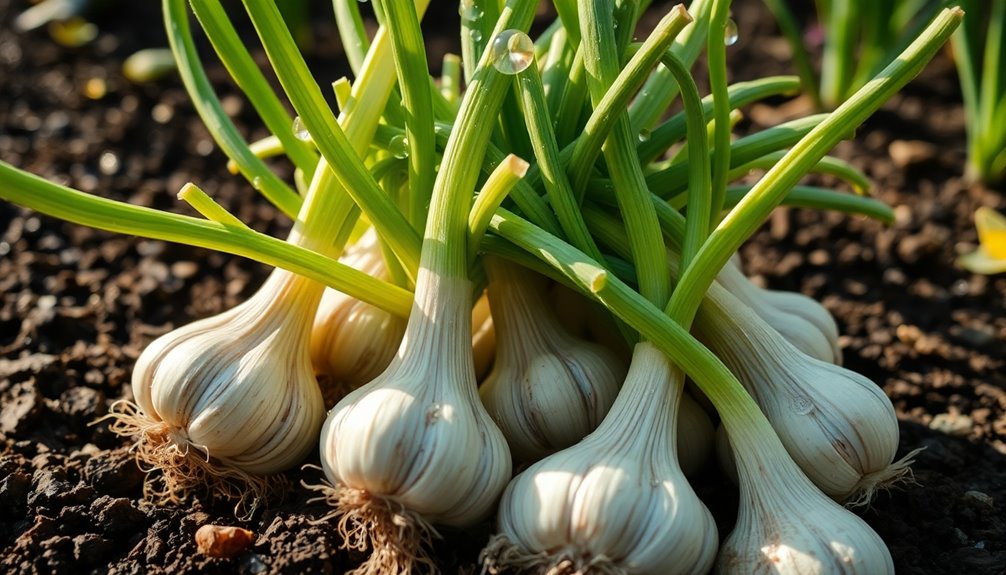
Garlic is an excellent choice for small gardens, not only because it's easy to grow but also for its rich flavor and numerous culinary uses. With minimal space required, you can plant garlic in containers or in between other plants. It thrives in well-drained soil and needs plenty of sunlight, making it perfect for your small outdoor area.
Here's a quick guide to help you get started:
| Variety | Planting Time | Harvest Time |
|---|---|---|
| Softneck Garlic | Fall (Sept-Oct) | Summer (Jun-Jul) |
| Hardneck Garlic | Fall (Sept-Oct) | Summer (Jun-Jul) |
| Elephant Garlic | Fall (Sept-Oct) | Late Summer (Aug) |
| Creole Garlic | Fall (Sept-Oct) | Summer (Jun-Jul) |
| Purple Stripe Garlic | Fall (Sept-Oct) | Summer (Jun-Jul) |
When planting, break apart the bulbs into individual cloves, and space them about 4-6 inches apart. Water them well but avoid overwatering. In around 6-8 months, you'll be able to enjoy your homegrown garlic, adding a burst of flavor to your dishes. Happy planting!
Cucumbers
Cucumbers are a fantastic addition to small gardens, as they grow quickly and can produce a bountiful harvest in a limited space. These versatile veggies thrive in warm weather, so plant them after the last frost for the best results.
Choose a sunny spot in your garden, as cucumbers love sunlight and will flourish with at least six hours of direct sunlight daily. You can grow cucumbers in the ground or use containers, making them perfect for small spaces.
If you opt for the ground, consider using trellises to support climbing varieties, saving valuable space while promoting air circulation. When selecting seeds, try both slicing and pickling varieties to diversify your harvest.
Water your cucumbers consistently, ensuring the soil remains moist but not soggy. Mulching around the base can help retain moisture and suppress weeds. Keep an eye out for pests like aphids and cucumber beetles, and take action early to prevent damage.
Harvest cucumbers when they're firm and bright green, ideally when they're about 6 to 8 inches long. Regular harvest encourages more growth, so enjoy the crisp, refreshing taste of your homegrown cucumbers all summer long!
Spinach
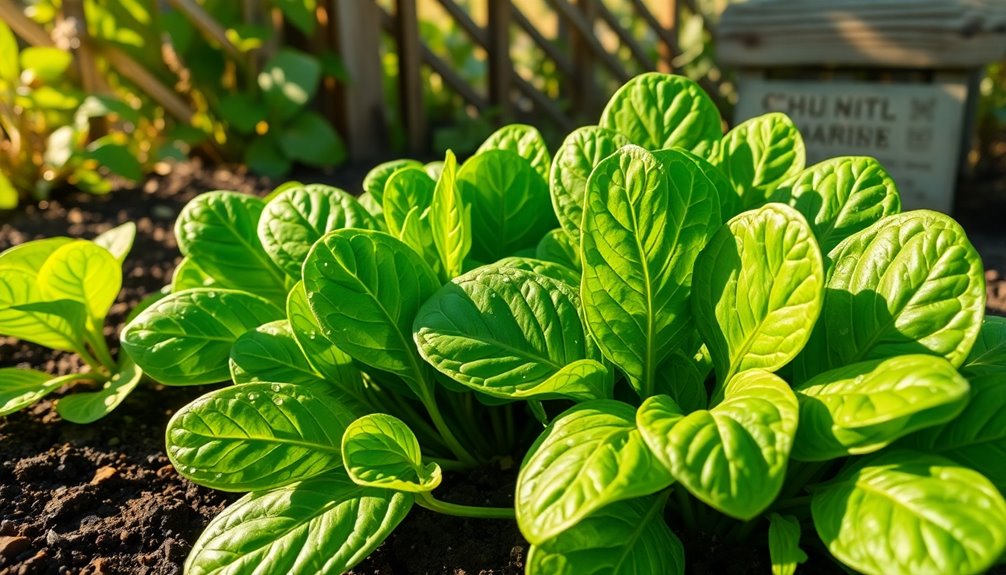
After enjoying the refreshing crunch of homegrown cucumbers, consider adding spinach to your small garden. This leafy green is not only nutritious but also easy to grow in limited spaces. Spinach thrives in cooler weather, making it perfect for spring or fall planting. You can sow seeds directly into the ground or use containers if that suits your garden layout better.
One of the best things about spinach is its fast growth. You'll see tender leaves ready for harvest in about 4 to 6 weeks. Plus, it's versatile—great in salads, smoothies, or cooked dishes. To help you decide, here's a quick comparison of spinach varieties:
| Variety | Flavor Profile |
|---|---|
| Savoy | Crisp and tender |
| Flat Leaf | Smooth and mild |
| Semi-Savoy | Both crisp and smooth |
Keep your soil well-drained and rich in organic matter to get the best results. Water regularly, especially in warmer months, and you'll enjoy a bountiful harvest. With spinach in your garden, you'll boost your meals with freshness and flavor!
Herbs
Whether you're seasoning a dish or garnishing a plate, growing your own herbs can elevate your culinary creations. Herbs are perfect for small gardens because they require minimal space and can thrive in containers.
Plus, there's nothing like the fresh aroma of freshly picked herbs!
Here are four easy-to-grow herbs that can enhance your cooking:
- Basil: This fragrant herb pairs beautifully with tomatoes and can be used in salads, pastas, and sauces.
- Parsley: A versatile herb, parsley adds a fresh flavor to almost any dish and is great as a garnish.
- Chives: With their mild onion flavor, chives are perfect for adding a pop of taste to soups or salads.
- Mint: Whether for tea, desserts, or savory dishes, mint brings a refreshing twist that's hard to beat.
You don't need a green thumb to grow these herbs. Just a sunny spot and regular watering will do!
Harvesting your own herbs not only boosts your meals but also brings a sense of satisfaction and connection to your food.
Frequently Asked Questions
How Much Sunlight Do These Vegetables Need Daily?
Different vegetables require varying amounts of sunlight daily. Generally, most need at least six hours of direct sunlight to thrive. Make sure to position your plants accordingly to maximize their growth and yield.
What Soil Type Is Best for Small Gardens?
Good soil makes a garden grow. For small gardens, well-draining loamy soil's best; it holds moisture while providing nutrients. You'll want to mix in organic matter to enhance fertility and encourage healthy plant growth.
How Often Should I Water My Vegetable Plants?
You should water your vegetable plants regularly, about once a week. However, check the soil moisture; if it feels dry an inch down, it's time to water. Adjust based on weather conditions and plant needs.
Can I Grow These Vegetables in Containers?
Yes, you can grow these vegetables in containers! Just ensure you choose the right-sized pots, use quality potting soil, and provide adequate sunlight and water. Container gardening is a fantastic way to maximize your space!
What Pests Should I Watch for in My Garden?
As you stroll through your garden, keep an eye out for aphids clinging to tender leaves, snails inching their way along stems, and beetles munching on your precious plants. They can turn your paradise into chaos!
Conclusion
In a small garden, your dreams can sprout like sunflowers reaching for the sky. By choosing the right vegetables—like leafy greens and vibrant cherry tomatoes—you'll cultivate a patch of paradise that bursts with flavor and color. Remember, each seed you plant is a promise of fresh harvests and culinary delights. So roll up your sleeves, embrace the earth, and let your garden thrive. With a little care, you'll be savoring the fruits of your labor in no time!

